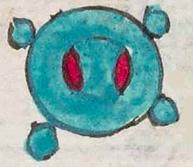Xiuhhuacan (Mdz13r)
This simplex glyph for turquoise (xihuitl) stands for the place name Xiuhhuacan. The visual source for the "hua" (possession) syllable is unclear. The locative suffix (-can) is not shown visually. The sign is basically round with an inner circle that has two small compartments painted red, and around the outer circle are four evenly-place smaller circles. All but the two red compartments are painted turquoise.
Stephanie Wood
The shape suggests a gleaming turquoise stone, but it could also share a reading of "year." Sometimes, the turquoise part of this glyph could be filled with small pieces of turquoise mosaic, such as has been published from a cache found at the Templo Mayor. Small turquoise pieces were easier to come by, and so they were often assembled in mosaic fashion. [See: J. Alden Mason, "Turquoise Mosaics from Northern Mexico," Museum Journal (Penn Museum), 20:2 (1929).]
Stephanie Wood
xiuhhuacan, puo
Xiuhhuacan, pueblo
Stephanie Wood
c. 1541, or by 1553 at the latest
Stephanie Wood
precious stones, years, calendar, calendars, calendrics, xiuhpohualli, año, turquesa, xihuitl, nombres de lugares

xihui(tl), turquoise, green, or grass, https://nahuatl.wired-humanities.org/content/xihuitl-0
xihui(tl), a year or a comet, https://nahuatl.wired-humanities.org/content/xihuitl
-hua-, possession or containment, https://nahuatl.wired-humanities.org/content/hua
-can (locative suffix), https://nahuatl.wired-humanities.org/content/can-2
Codex Mendoza, folio 13 recto, https://digital.bodleian.ox.ac.uk/objects/2fea788e-2aa2-4f08-b6d9-648c00..., image 36 of 188.
The Bodleian Libraries, University of Oxford, hold the original manuscript, the MS. Arch. Selden. A. 1. This image is published here under the UK Creative Commons, “Attribution-NonCommercial-ShareAlike 3.0 License” (CC-BY-NC-SA 3.0).






